Researching Caffeine's Dose-Dependent Effects on Cycling Performance
VerifiedAdded on 2023/04/20
|5
|1232
|146
Homework Assignment
AI Summary
This assignment investigates the potential benefits of caffeine on cycling performance, focusing on whether it can enhance performance compared to traditional training methods and a healthy diet, and if these effects are dose-dependent. The research question was developed using the PICO format (Population, Intervention, Comparison, Outcome), with 'Cyclists' as the population, 'caffeine' as the intervention, 'standard training methods' as the comparison, and 'improved cycling performance' as the outcome. A literature search was conducted using the Medline database, employing keywords such as 'cycling,' 'caffeine,' and 'athletic performance.' The search strategy involved using Boolean operators and filters to refine the results, ultimately screening titles and abstracts to identify relevant articles. The reflection highlights the importance of a structured approach to database searching and the value of preliminary research in narrowing down relevant studies. The assignment concludes by referencing relevant research articles, indicating a comprehensive approach to exploring the research question.
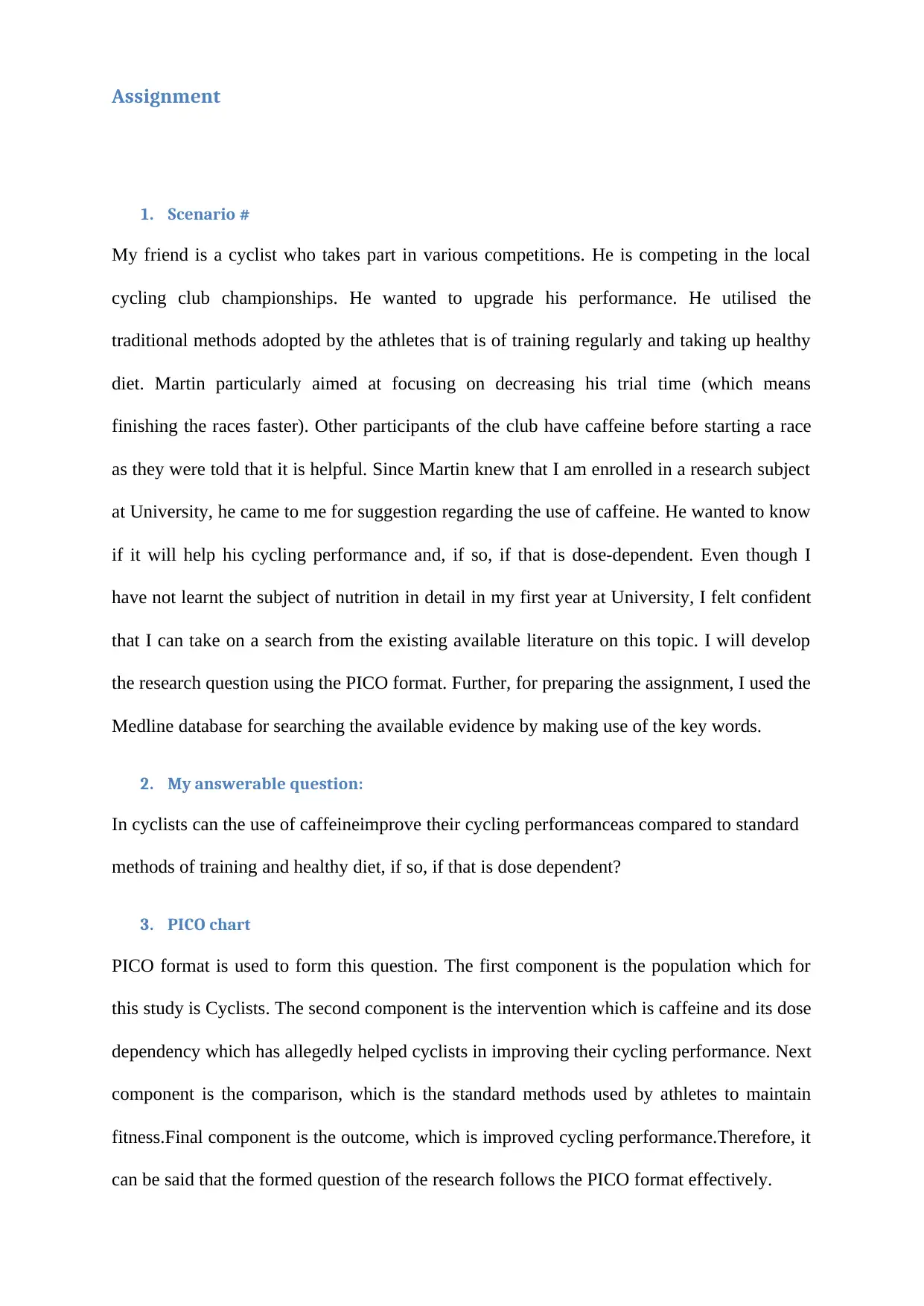
Assignment
1. Scenario #
My friend is a cyclist who takes part in various competitions. He is competing in the local
cycling club championships. He wanted to upgrade his performance. He utilised the
traditional methods adopted by the athletes that is of training regularly and taking up healthy
diet. Martin particularly aimed at focusing on decreasing his trial time (which means
finishing the races faster). Other participants of the club have caffeine before starting a race
as they were told that it is helpful. Since Martin knew that I am enrolled in a research subject
at University, he came to me for suggestion regarding the use of caffeine. He wanted to know
if it will help his cycling performance and, if so, if that is dose-dependent. Even though I
have not learnt the subject of nutrition in detail in my first year at University, I felt confident
that I can take on a search from the existing available literature on this topic. I will develop
the research question using the PICO format. Further, for preparing the assignment, I used the
Medline database for searching the available evidence by making use of the key words.
2. My answerable question:
In cyclists can the use of caffeineimprove their cycling performanceas compared to standard
methods of training and healthy diet, if so, if that is dose dependent?
3. PICO chart
PICO format is used to form this question. The first component is the population which for
this study is Cyclists. The second component is the intervention which is caffeine and its dose
dependency which has allegedly helped cyclists in improving their cycling performance. Next
component is the comparison, which is the standard methods used by athletes to maintain
fitness.Final component is the outcome, which is improved cycling performance.Therefore, it
can be said that the formed question of the research follows the PICO format effectively.
1. Scenario #
My friend is a cyclist who takes part in various competitions. He is competing in the local
cycling club championships. He wanted to upgrade his performance. He utilised the
traditional methods adopted by the athletes that is of training regularly and taking up healthy
diet. Martin particularly aimed at focusing on decreasing his trial time (which means
finishing the races faster). Other participants of the club have caffeine before starting a race
as they were told that it is helpful. Since Martin knew that I am enrolled in a research subject
at University, he came to me for suggestion regarding the use of caffeine. He wanted to know
if it will help his cycling performance and, if so, if that is dose-dependent. Even though I
have not learnt the subject of nutrition in detail in my first year at University, I felt confident
that I can take on a search from the existing available literature on this topic. I will develop
the research question using the PICO format. Further, for preparing the assignment, I used the
Medline database for searching the available evidence by making use of the key words.
2. My answerable question:
In cyclists can the use of caffeineimprove their cycling performanceas compared to standard
methods of training and healthy diet, if so, if that is dose dependent?
3. PICO chart
PICO format is used to form this question. The first component is the population which for
this study is Cyclists. The second component is the intervention which is caffeine and its dose
dependency which has allegedly helped cyclists in improving their cycling performance. Next
component is the comparison, which is the standard methods used by athletes to maintain
fitness.Final component is the outcome, which is improved cycling performance.Therefore, it
can be said that the formed question of the research follows the PICO format effectively.
Paraphrase This Document
Need a fresh take? Get an instant paraphrase of this document with our AI Paraphraser
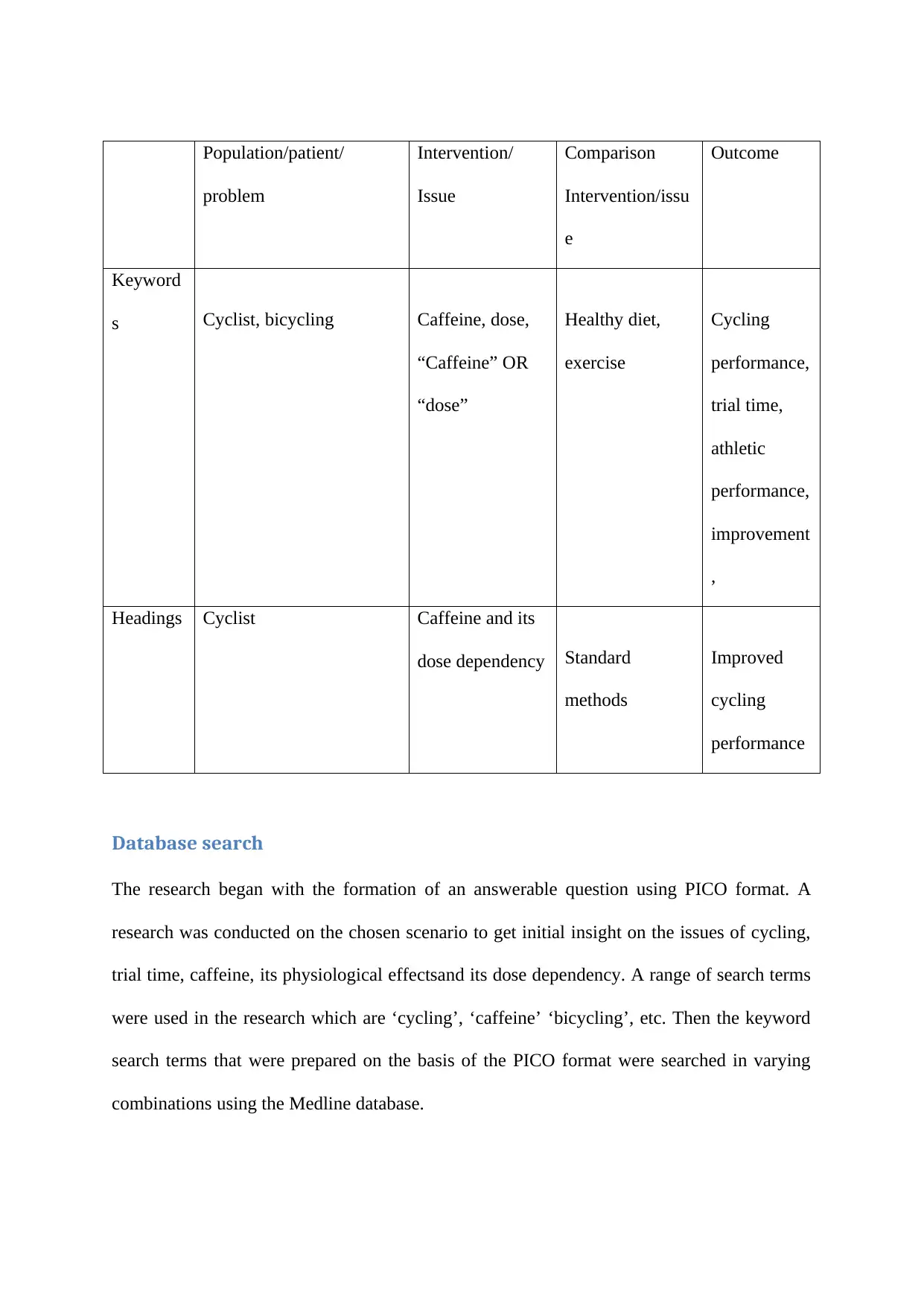
Population/patient/
problem
Intervention/
Issue
Comparison
Intervention/issu
e
Outcome
Keyword
s Cyclist, bicycling Caffeine, dose,
“Caffeine” OR
“dose”
Healthy diet,
exercise
Cycling
performance,
trial time,
athletic
performance,
improvement
,
Headings Cyclist Caffeine and its
dose dependency Standard
methods
Improved
cycling
performance
Database search
The research began with the formation of an answerable question using PICO format. A
research was conducted on the chosen scenario to get initial insight on the issues of cycling,
trial time, caffeine, its physiological effectsand its dose dependency. A range of search terms
were used in the research which are ‘cycling’, ‘caffeine’ ‘bicycling’, etc. Then the keyword
search terms that were prepared on the basis of the PICO format were searched in varying
combinations using the Medline database.
problem
Intervention/
Issue
Comparison
Intervention/issu
e
Outcome
Keyword
s Cyclist, bicycling Caffeine, dose,
“Caffeine” OR
“dose”
Healthy diet,
exercise
Cycling
performance,
trial time,
athletic
performance,
improvement
,
Headings Cyclist Caffeine and its
dose dependency Standard
methods
Improved
cycling
performance
Database search
The research began with the formation of an answerable question using PICO format. A
research was conducted on the chosen scenario to get initial insight on the issues of cycling,
trial time, caffeine, its physiological effectsand its dose dependency. A range of search terms
were used in the research which are ‘cycling’, ‘caffeine’ ‘bicycling’, etc. Then the keyword
search terms that were prepared on the basis of the PICO format were searched in varying
combinations using the Medline database.
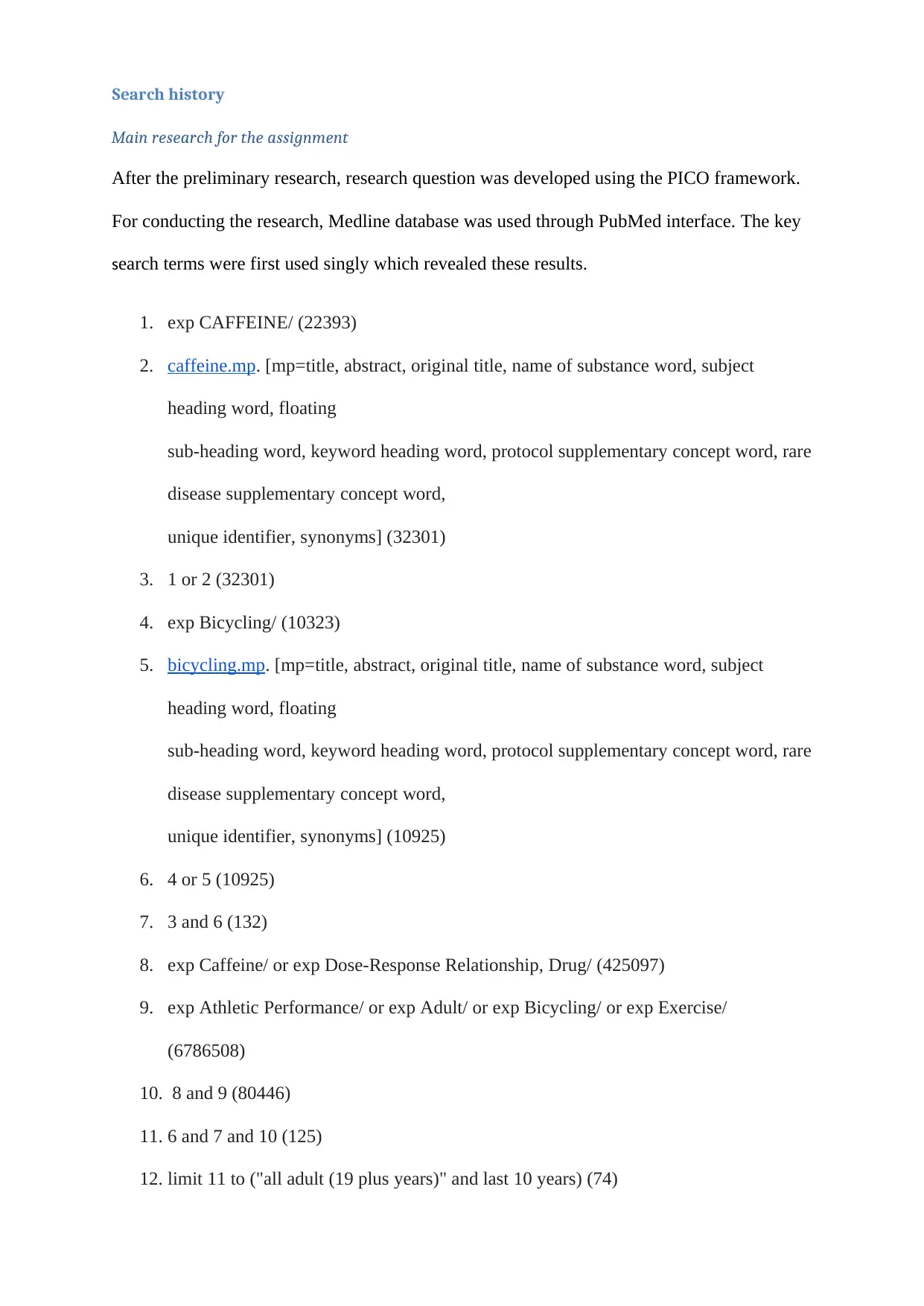
Search history
Main research for the assignment
After the preliminary research, research question was developed using the PICO framework.
For conducting the research, Medline database was used through PubMed interface. The key
search terms were first used singly which revealed these results.
1. exp CAFFEINE/ (22393)
2. caffeine.mp. [mp=title, abstract, original title, name of substance word, subject
heading word, floating
sub-heading word, keyword heading word, protocol supplementary concept word, rare
disease supplementary concept word,
unique identifier, synonyms] (32301)
3. 1 or 2 (32301)
4. exp Bicycling/ (10323)
5. bicycling.mp. [mp=title, abstract, original title, name of substance word, subject
heading word, floating
sub-heading word, keyword heading word, protocol supplementary concept word, rare
disease supplementary concept word,
unique identifier, synonyms] (10925)
6. 4 or 5 (10925)
7. 3 and 6 (132)
8. exp Caffeine/ or exp Dose-Response Relationship, Drug/ (425097)
9. exp Athletic Performance/ or exp Adult/ or exp Bicycling/ or exp Exercise/
(6786508)
10. 8 and 9 (80446)
11. 6 and 7 and 10 (125)
12. limit 11 to ("all adult (19 plus years)" and last 10 years) (74)
Main research for the assignment
After the preliminary research, research question was developed using the PICO framework.
For conducting the research, Medline database was used through PubMed interface. The key
search terms were first used singly which revealed these results.
1. exp CAFFEINE/ (22393)
2. caffeine.mp. [mp=title, abstract, original title, name of substance word, subject
heading word, floating
sub-heading word, keyword heading word, protocol supplementary concept word, rare
disease supplementary concept word,
unique identifier, synonyms] (32301)
3. 1 or 2 (32301)
4. exp Bicycling/ (10323)
5. bicycling.mp. [mp=title, abstract, original title, name of substance word, subject
heading word, floating
sub-heading word, keyword heading word, protocol supplementary concept word, rare
disease supplementary concept word,
unique identifier, synonyms] (10925)
6. 4 or 5 (10925)
7. 3 and 6 (132)
8. exp Caffeine/ or exp Dose-Response Relationship, Drug/ (425097)
9. exp Athletic Performance/ or exp Adult/ or exp Bicycling/ or exp Exercise/
(6786508)
10. 8 and 9 (80446)
11. 6 and 7 and 10 (125)
12. limit 11 to ("all adult (19 plus years)" and last 10 years) (74)
⊘ This is a preview!⊘
Do you want full access?
Subscribe today to unlock all pages.

Trusted by 1+ million students worldwide
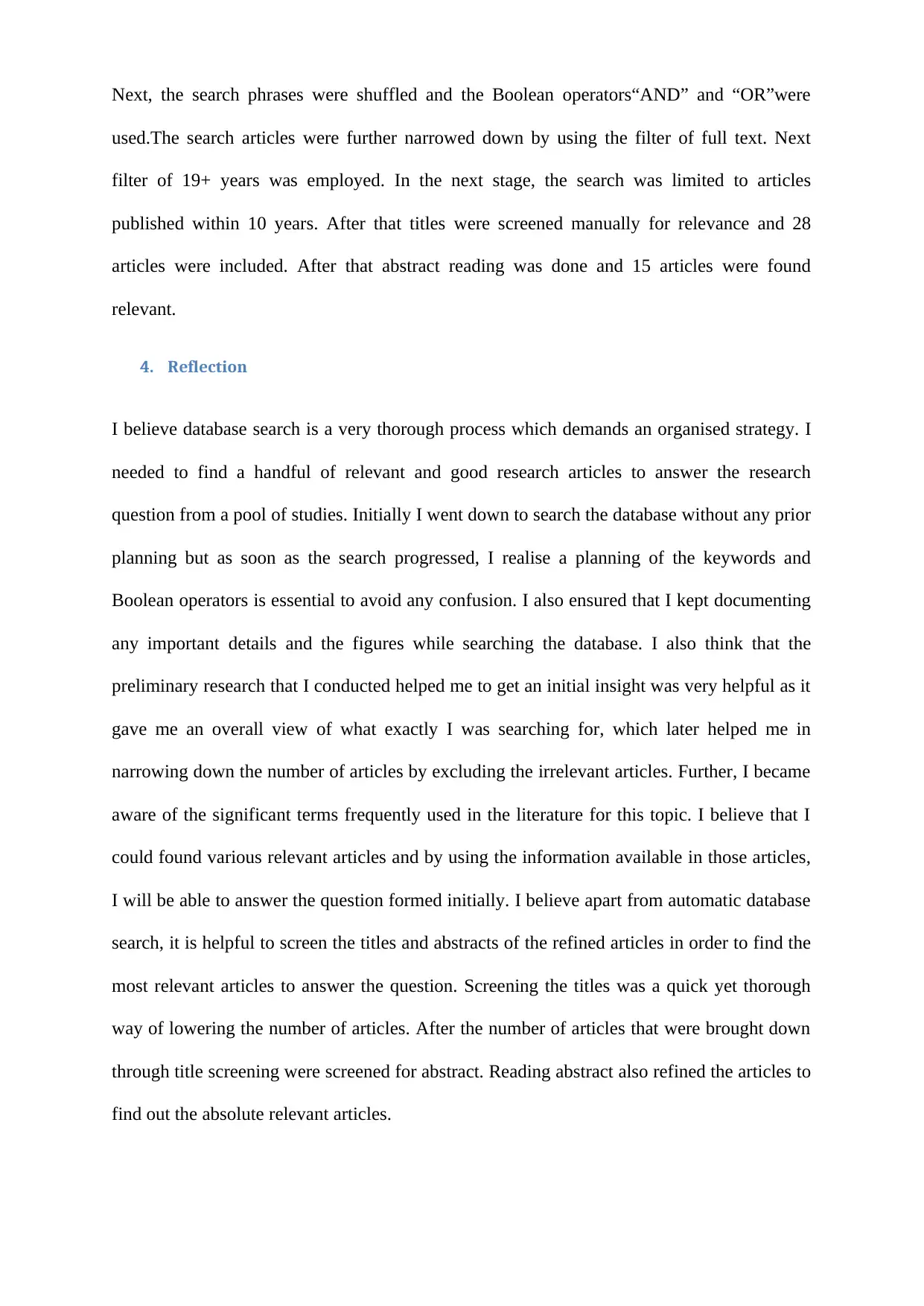
Next, the search phrases were shuffled and the Boolean operators“AND” and “OR”were
used.The search articles were further narrowed down by using the filter of full text. Next
filter of 19+ years was employed. In the next stage, the search was limited to articles
published within 10 years. After that titles were screened manually for relevance and 28
articles were included. After that abstract reading was done and 15 articles were found
relevant.
4. Reflection
I believe database search is a very thorough process which demands an organised strategy. I
needed to find a handful of relevant and good research articles to answer the research
question from a pool of studies. Initially I went down to search the database without any prior
planning but as soon as the search progressed, I realise a planning of the keywords and
Boolean operators is essential to avoid any confusion. I also ensured that I kept documenting
any important details and the figures while searching the database. I also think that the
preliminary research that I conducted helped me to get an initial insight was very helpful as it
gave me an overall view of what exactly I was searching for, which later helped me in
narrowing down the number of articles by excluding the irrelevant articles. Further, I became
aware of the significant terms frequently used in the literature for this topic. I believe that I
could found various relevant articles and by using the information available in those articles,
I will be able to answer the question formed initially. I believe apart from automatic database
search, it is helpful to screen the titles and abstracts of the refined articles in order to find the
most relevant articles to answer the question. Screening the titles was a quick yet thorough
way of lowering the number of articles. After the number of articles that were brought down
through title screening were screened for abstract. Reading abstract also refined the articles to
find out the absolute relevant articles.
used.The search articles were further narrowed down by using the filter of full text. Next
filter of 19+ years was employed. In the next stage, the search was limited to articles
published within 10 years. After that titles were screened manually for relevance and 28
articles were included. After that abstract reading was done and 15 articles were found
relevant.
4. Reflection
I believe database search is a very thorough process which demands an organised strategy. I
needed to find a handful of relevant and good research articles to answer the research
question from a pool of studies. Initially I went down to search the database without any prior
planning but as soon as the search progressed, I realise a planning of the keywords and
Boolean operators is essential to avoid any confusion. I also ensured that I kept documenting
any important details and the figures while searching the database. I also think that the
preliminary research that I conducted helped me to get an initial insight was very helpful as it
gave me an overall view of what exactly I was searching for, which later helped me in
narrowing down the number of articles by excluding the irrelevant articles. Further, I became
aware of the significant terms frequently used in the literature for this topic. I believe that I
could found various relevant articles and by using the information available in those articles,
I will be able to answer the question formed initially. I believe apart from automatic database
search, it is helpful to screen the titles and abstracts of the refined articles in order to find the
most relevant articles to answer the question. Screening the titles was a quick yet thorough
way of lowering the number of articles. After the number of articles that were brought down
through title screening were screened for abstract. Reading abstract also refined the articles to
find out the absolute relevant articles.
Paraphrase This Document
Need a fresh take? Get an instant paraphrase of this document with our AI Paraphraser
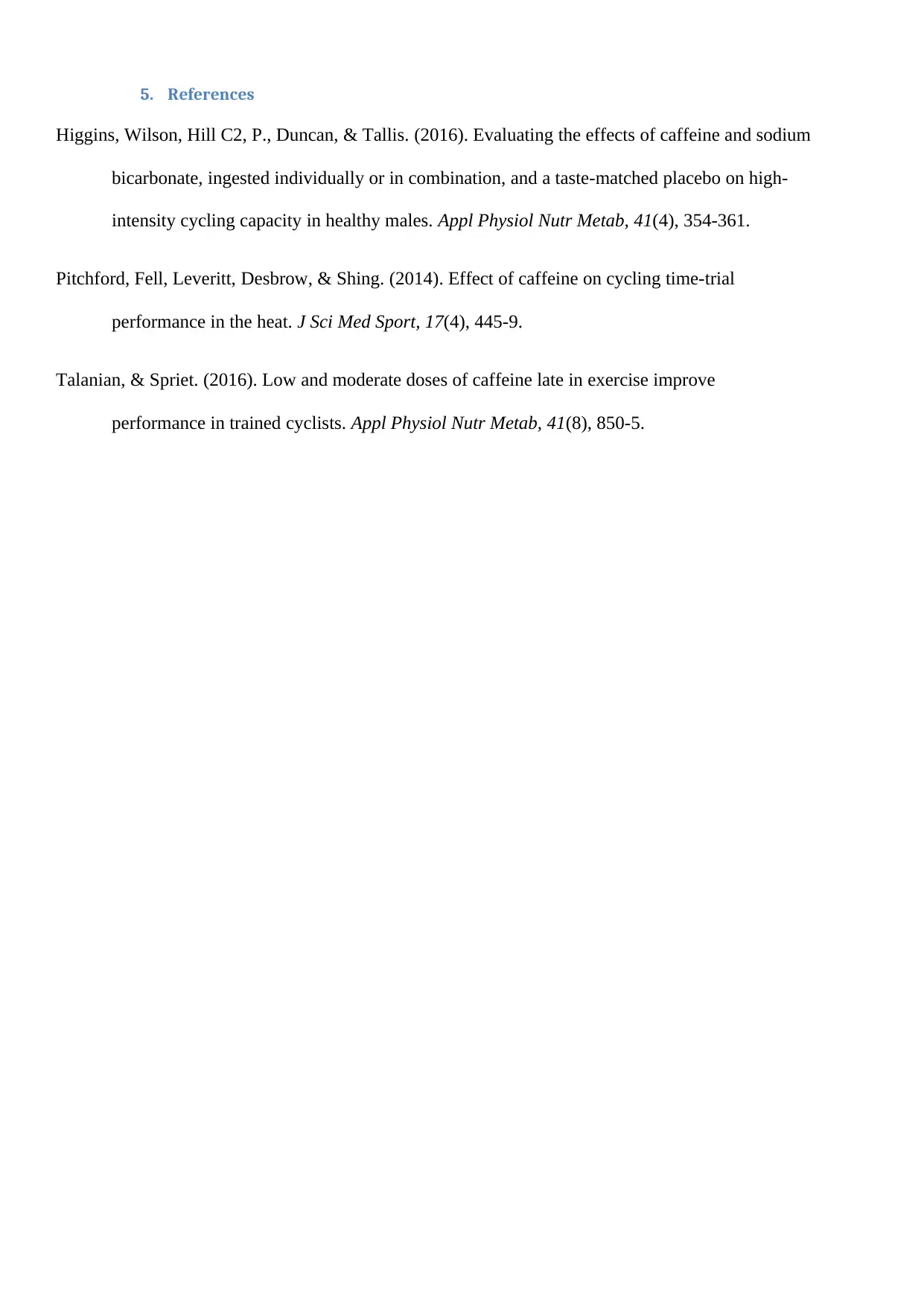
5. References
Higgins, Wilson, Hill C2, P., Duncan, & Tallis. (2016). Evaluating the effects of caffeine and sodium
bicarbonate, ingested individually or in combination, and a taste-matched placebo on high-
intensity cycling capacity in healthy males. Appl Physiol Nutr Metab, 41(4), 354-361.
Pitchford, Fell, Leveritt, Desbrow, & Shing. (2014). Effect of caffeine on cycling time-trial
performance in the heat. J Sci Med Sport, 17(4), 445-9.
Talanian, & Spriet. (2016). Low and moderate doses of caffeine late in exercise improve
performance in trained cyclists. Appl Physiol Nutr Metab, 41(8), 850-5.
Higgins, Wilson, Hill C2, P., Duncan, & Tallis. (2016). Evaluating the effects of caffeine and sodium
bicarbonate, ingested individually or in combination, and a taste-matched placebo on high-
intensity cycling capacity in healthy males. Appl Physiol Nutr Metab, 41(4), 354-361.
Pitchford, Fell, Leveritt, Desbrow, & Shing. (2014). Effect of caffeine on cycling time-trial
performance in the heat. J Sci Med Sport, 17(4), 445-9.
Talanian, & Spriet. (2016). Low and moderate doses of caffeine late in exercise improve
performance in trained cyclists. Appl Physiol Nutr Metab, 41(8), 850-5.
1 out of 5
Related Documents
Your All-in-One AI-Powered Toolkit for Academic Success.
+13062052269
info@desklib.com
Available 24*7 on WhatsApp / Email
![[object Object]](/_next/static/media/star-bottom.7253800d.svg)
Unlock your academic potential
Copyright © 2020–2025 A2Z Services. All Rights Reserved. Developed and managed by ZUCOL.





